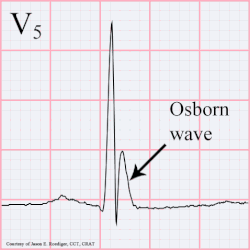J wave


A J wave — also known as Osborn wave, camel-hump sign, late delta wave, hathook junction, hypothermic wave,
J waves are positive deflections occurring at the junction between the QRS complex and the ST segment,[3][4] where the S point, also known as the J point, has a myocardial infarction-like elevation.
Causes
They are usually observed in people suffering from
History
The prominent J deflection attributed to hypothermia was first reported in 1938 by Tomaszewski. These waves were then definitively described in 1953 by John J. Osborn (1917–2014) and were named in his honor.[7] Over time, the wave has increasingly been referred to as a J wave, though is still sometimes referred to as the Osborn wave in most part due to Osborn's article in the American Journal of Physiology on experimental hypothermia.[8]
References
- PMID 15902836.
- PMID 16943886.
- ^ "ecg_6lead018.html". Retrieved 2008-12-20.
- ^ "THE MERCK MANUAL OF GERIATRICS, Ch. 67, Hyperthermia and Hypothermia, Fig. 67-1". Retrieved 2008-12-20.
- ISBN 978-0-323-05472-0.
- ^ PMID 29723608.
- PMID 13114420.
- PMID 23882340.
